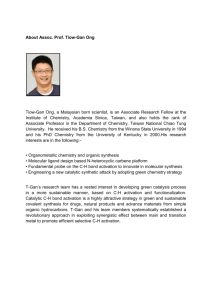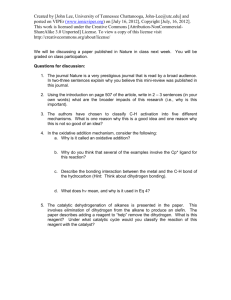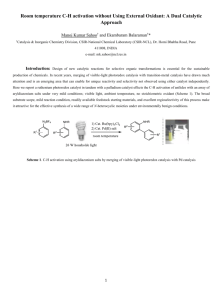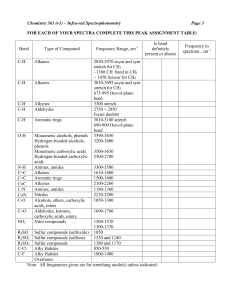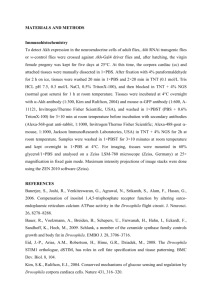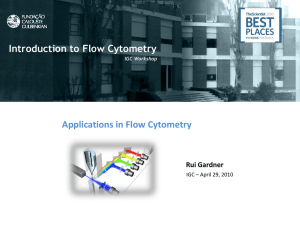DOC
advertisement
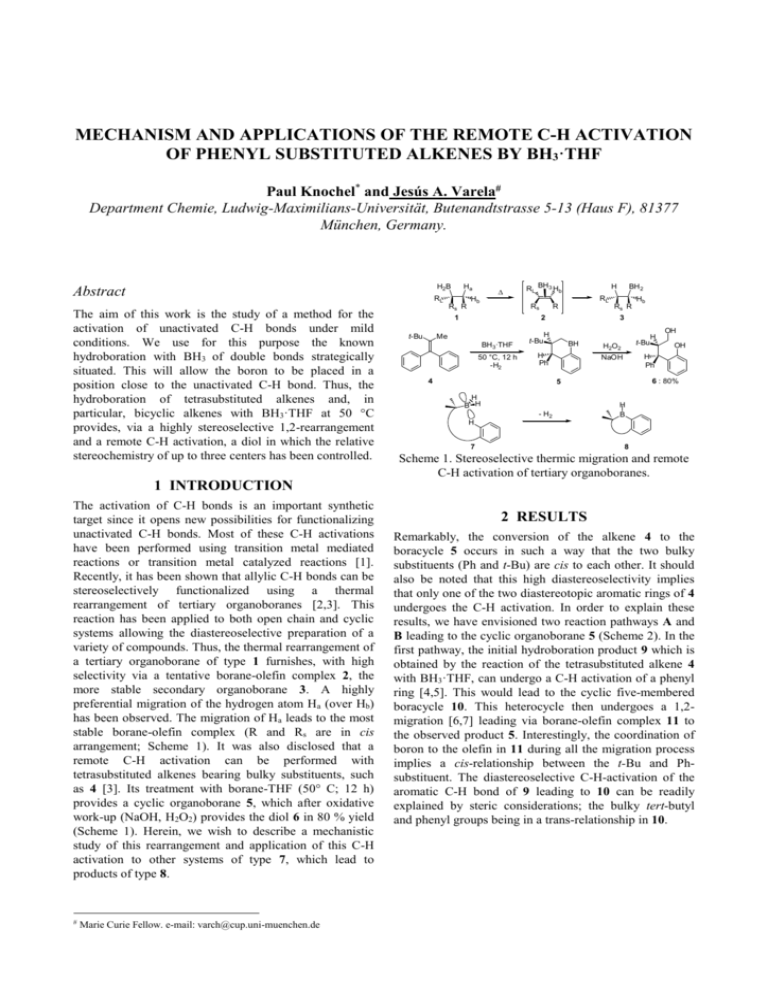
MECHANISM AND APPLICATIONS OF THE REMOTE C-H ACTIVATION OF PHENYL SUBSTITUTED ALKENES BY BH3·THF Paul Knochel* and Jesús A. Varela# Department Chemie, Ludwig-Maximilians-Universität, Butenandtstrasse 5-13 (Haus F), 81377 München, Germany. H2B Abstract Ha RL The aim of this work is the study of a method for the activation of unactivated C-H bonds under mild conditions. We use for this purpose the known hydroboration with BH3 of double bonds strategically situated. This will allow the boron to be placed in a position close to the unactivated C-H bond. Thus, the hydroboration of tetrasubstituted alkenes and, in particular, bicyclic alkenes with BH3·THF at 50 °C provides, via a highly stereoselective 1,2-rearrangement and a remote C-H activation, a diol in which the relative stereochemistry of up to three centers has been controlled. Rs R Hb Rs H Me BH 3·THF R 50 °C, 12 h -H2 t-Bu BH 2 RL Rs R 2 1 t-Bu RL BH 3 Hb Hb 3 H BH H Ph 4 t-Bu H2O2 OH 6 : 80% 5 - H2 OH H Ph NaOH H B H H H B H 7 8 Scheme 1. Stereoselective thermic migration and remote C-H activation of tertiary organoboranes. 1 INTRODUCTION The activation of C-H bonds is an important synthetic target since it opens new possibilities for functionalizing unactivated C-H bonds. Most of these C-H activations have been performed using transition metal mediated reactions or transition metal catalyzed reactions [1]. Recently, it has been shown that allylic C-H bonds can be stereoselectively functionalized using a thermal rearrangement of tertiary organoboranes [2,3]. This reaction has been applied to both open chain and cyclic systems allowing the diastereoselective preparation of a variety of compounds. Thus, the thermal rearrangement of a tertiary organoborane of type 1 furnishes, with high selectivity via a tentative borane-olefin complex 2, the more stable secondary organoborane 3. A highly preferential migration of the hydrogen atom Ha (over Hb) has been observed. The migration of Ha leads to the most stable borane-olefin complex (R and Rs are in cis arrangement; Scheme 1). It was also disclosed that a remote C-H activation can be performed with tetrasubstituted alkenes bearing bulky substituents, such as 4 [3]. Its treatment with borane-THF (50° C; 12 h) provides a cyclic organoborane 5, which after oxidative work-up (NaOH, H2O2) provides the diol 6 in 80 % yield (Scheme 1). Herein, we wish to describe a mechanistic study of this rearrangement and application of this C-H activation to other systems of type 7, which lead to products of type 8. # Marie Curie Fellow. e-mail: varch@cup.uni-muenchen.de 2 RESULTS Remarkably, the conversion of the alkene 4 to the boracycle 5 occurs in such a way that the two bulky substituents (Ph and t-Bu) are cis to each other. It should also be noted that this high diastereoselectivity implies that only one of the two diastereotopic aromatic rings of 4 undergoes the C-H activation. In order to explain these results, we have envisioned two reaction pathways A and B leading to the cyclic organoborane 5 (Scheme 2). In the first pathway, the initial hydroboration product 9 which is obtained by the reaction of the tetrasubstituted alkene 4 with BH3·THF, can undergo a C-H activation of a phenyl ring [4,5]. This would lead to the cyclic five-membered boracycle 10. This heterocycle then undergoes a 1,2migration [6,7] leading via borane-olefin complex 11 to the observed product 5. Interestingly, the coordination of boron to the olefin in 11 during all the migration process implies a cis-relationship between the t-Bu and Phsubstituent. The diastereoselective C-H-activation of the aromatic C-H bond of 9 leading to 10 can be readily explained by steric considerations; the bulky tert-butyl and phenyl groups being in a trans-relationship in 10. product can be explained as the alkenes E-18 and Z-18 slowly isomerize under the reaction conditions at 50 °C. HO t-Bu H t-Bu OH 1) BH3·THF, 50 °C, 24 h Ph H 2) H2O2, NaOH 17 : 60%; dr > 99% 16 t-Bu Ph t-Bu H OH 1) BH3·THF, 50 °C, 17 h p-Tol Ph 2) H2O2, NaOH t-Bu OH p-Tol H 19a with E-18 with Z-18 E-18 and Z-18 OH OH H 19b 81%; 19a:19b= 4:1 70%; 19a:19b= 1:4 Scheme 3. Rearrangement of the hydroboration of trisubstituted olefins. Scheme 2. Mechanism of the C-H insertion, 1,2-migration of the tertiary borane 9. An alternative pathway (Pathway B) is also possible. In this case, the 1,2-migration leading to the primary organoborane 12 proceeds first and is followed by a C-H activation of the aromatic ring, leading to the boracycle 5. Although the 1,2-migration process of 9 to 12 should readily occur under the reaction conditions, the observed diastereoselectivity of the C-H rearrangement is difficult to explain (cis-arrangement of the substituents in 5). We have therefore performed a series of experiments, which clearly prove the proposed pathway A. Firstly, we have prepared the isomeric alkene 13 and have submitted it to the hydroboration conditions used for the conversion of 4 to 5 (BH3·THF (3 equiv), 50 °C, 12 h). We have observed after oxidative work-up (H2O2, NaOH) none of the diol 6, but only the alcohol 14, which was isolated in 63 % yield showing that the intermediate organoborane 12 is not an intermediate of the C-H activation process (Scheme 2). Furthermore, we have interrupted the hydroboration of 4 after one hour reaction time. The oxidative work-up of the reaction mixture provides two products, the final diol 6 (25 % yield), but also the tertiary diol 15 (32 % yield). This diol 15 is clearly the resulting oxidation product of the cyclic organoborane 10 postulated in the pathway A. The relative stereochemistry of 6 and 15 was established by X-ray analysis. These results imply that the C-H activation reaction is especially efficient if a boracyclopentane is formed. We have therefore prepared the trisubstituted alkene 16 and were pleased to find that the hydroboration of 16 with BH3·THF and subsequent heating of 16 in THF at 50 °C for 24 h furnished, after oxidative work-up, the diastereomerically pure diol 17 in 60 % yield (Scheme 3). We also prepared the E- and Ztolyl substituted olefins E-18 and Z-18 and found as expected in the case of E-18, a selective activation of the tolyl ring (19a:19b = 4:1), whereas with the Z-isomer (Z18), a selective activation of the phenyl ring was observed (19a:19b = 1:4). The formation of 20% of the other C-H In order to extend the scope of this remote C-H activation, we have examined the hydroboration of some related tetrasubstituted olefins. Thus, the [2.2.2] bicyclic alkene 20 reacts with BH3·THF at 50 °C (36 h) and undergoes a selective boron migration leading, after oxidative work-up, to the primary alcohol 21. Further heating of the alkene 20 and BH3·THF at 90 °C for 24 h leads to a C-H activation of the phenyl ring and gives, after oxidation with H2O2/NaOH, the diol 22 (Scheme 4). 1) BH3·THF 50 °C, 36 h 1) BH3·THF 90 °C, 24 h OH 2) H2O2, NaOH OH 2) H2O2, NaOH HO Ph 21 : 57% Ha 20 1) BH3·THF (3 equiv) Hb 50 °C, 24 h 22 : 57% BH 2 Me Ha 2) H2O2, NaOH OH OH HO Me Ph 23 25 24 : 57% Scheme 4. Stereoselective 1,2-migration and remote C-H activation of bicyclic tetrasubstituted olefins. With this system, the C-H activation is not possible in the initial hydroboration product (trans arrangement of the boron and the phenyl ring) and a boron-migration occurs before the C-H activation (opposite reaction sequence as described in Scheme 2). The corresponding ethyl substituted alkene 23 undergoes, as observed in previous cases [2,3], a faster 1,2-migration and furnishes only one diastereomeric diol (24) with a relative control of these adjacent chiral centers. The observed diastereoselectivity is readily explained by the model depicted in Scheme 1. Thus, only the diastereotopic hydrogen Hb undergoes the dehydroboration step leading to the less sterically hindered olefin 25. 3 CONCLUSION We have determined the mechanism of the diastereoselective activation of aryl substituted alkenes and found several new systems undergoing this stereoselective C-H activation. We have shown that this new reaction sequence allows the diastereoselective synthesis of up to three contiguous chiral centers. Further extensions and application are currently underway in our laboratories. [2] 4 ACKNOWLEDGMENTS This research has been supported by a Marie Curie Fellowship of the European Community programme “Improving Human Research Potential and the Socioeconomic Knowledge Base” under contract number HPMFCT-2000-00451, Jesús A. Varela is a MCFA member number 3697. We thank the DFG (SFB 260, Leibniz-Programm) and Chemetall GmbH (Frankfurt) and Degussa-Hüls AG (Hanau) for generous gifts of chemicals. 5 TIPICAL PROCEDURE FOR THE C-H REMOTE ACTIVATION The preparation of 1-(2-hydroxyphenyl)-3,3-dimethyl-1phenyl-2-butanol (17) is representative for the reactions of remote C-H activation. A solution of BH3·THF (9 mL, 9 mmol, 3 equiv) was added to a solution of 3,3-dimethyl-1,1-diphenyl-1-butene (16) (0.71 g, 3 mmol) in THF (25 mL) at room temperature under argon atmosphere. After stirring at 50 °C for 24 h the resulting mixture was quenched by addition of 2M NaOH (12 mL) and 30% H2O2(12 mL). The resulting mixture was stirred at room temperature for 30 min and was then extracted with diethyl ether (10 mL). The combined organic layers were dried over MgSO4, filtered and concentrated under reduced pressure. Column chromatography of the residue on silica flash (elution with pentane/diethyl ether 7/3) afforded the product 17 as a white solid (478 mg, 60% yield). All the compounds were characterised by 1H-NMR, 13CNMR, mass spectroscopy, high-resolution mass spectroscopy and infrarred. 6 REFERENCES [1] (a) A. H. Janowicz, R. G. Bergmann, J. Am. Chem. Soc. 1982, 104, 352; (b) A. D. Ryabov, Chem. Rev. 1990, 90, 403; (c) W. Adam, B. Nestler, Angew. Chem. Int. Ed. Engl. 1993, 32, 733; (d) S. Murai, F. Kaikiuchi, S. Sekiine, Y. Tanaka, A. Kamatani, M. Sonoda, N. Chatani, Nature 1993, 366, 529; (e) B. A. Arndtsen, R. G. Bergmann, Science 1995, 270, 1970; (f) R. H. Crabtree, Chem. Rev. 1995, 95, 987; (g) M. T. Rispens, C. Zardervan, B. L. Feringa, Tetrahedron: Asymmetry 1995, 6, 661; (h) M. Sonoda, F. Kakiuchi, N. Chatani, S. Murai, J. Organomet. Chem. 1995, 504, 151; (i) [3] [4] [5] [6] [7] B. M. Trost, K. Iwi, I. W. Davies, J. Am. Chem. Soc. 1995, 117, 5371; (j) N. A. Williams, Y. Uchimaru, M. Tanaka, J. Chem. Soc., Chem. Commun. 1995, 1129; (k) P. J. Alaimo, B. A. Arndtsen, R. G. Bergmann, J. Am. Chem. Soc. 1997, 119, 5269; (l) R. Grigg, V. Savic, Tetrahedron Lett. 1997, 38, 5737; (m) H. F. Luecke, R. G. Bergmann, J. Am. Chem. Soc. 1997, 119, 11538; (n) A. Miyaluji, T. Katsuki, Tetrahedron 1998, 54, 19339; (o) J. A. Johnson, D. Sames, J. Am. Chem. Soc. 2000, 122, 6321. (a)F. Lhermitte, P. Knochel, Angew. Chem. Int. Ed. 1998, 37, 2460; (b) L. O. Bromm, H. Laaziri, F. Lhermitte, K. Harms, P. Knochel, J. Am. Chem. Soc. 2000, 122, 10218. H. Laaziri, L. O. Bromm, F. Lhermitte, R. M. Gschwind, P. Knochel, J. Am. Chem. Soc. 1999, 121, 6940. For a theoretical study of the direct borane-hydrocarbon dehydrogenation: B. Goldfuss, P. Knochel, L. O. Bromm, K. Knapp, Angew. Chem. Int. Ed. 2000, 39, 4136. W. Köster, W. Siebert, Methoden der Organischen Chemie (Houben-Weyl) 4th Ed.; Thieme: Stuttgart, 1952; 1982; Vol. 13, part 3a, pp 1-908. For mechanistic studies on 1,2-boron migrations, see: (a) S. E. Wood, B. Rickborn, J. Org. Chem. 1983, 48, 555; (b) L. D. Field, S. P. Galagher, Tetrahedron Lett. 1985, 26, 6125. (a) H. C. Brown, G. Zweifel, J. Am. Chem. Soc. 1966, 88, 1433; (b) H. C. Brown, M. V. Bhatt, J. Am. Chem. Soc. 1966, 88, 1440.
